The fortress Ichan-Kala
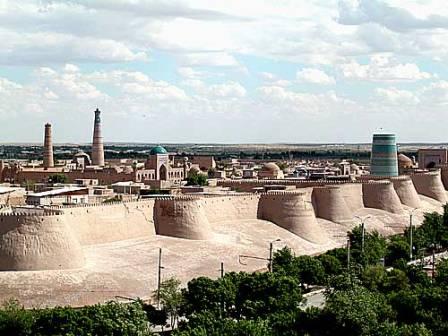 The mysterious city Khiva has managed to keep the image of an exotic eastern city in its oldest part - the fortress Ichan-Kala, where there are numerous monuments. In Khiva city, there traditional division into two separate one from the other parts: the inner city - Ichan-Kala and the outer city - Dishan-Kala. Ichan-Kala became the first UNESCO World Heritage Site in Central Asia. Erected over the centuries, the fortifications and palaces, mosques and madrasas, mausoleums and minarets, caravanserais and baths made of Ichan-Kala in a unique city-museum. The official status of the ancient city of Khiva was the reserve in 1968.
The mysterious city Khiva has managed to keep the image of an exotic eastern city in its oldest part - the fortress Ichan-Kala, where there are numerous monuments. In Khiva city, there traditional division into two separate one from the other parts: the inner city - Ichan-Kala and the outer city - Dishan-Kala. Ichan-Kala became the first UNESCO World Heritage Site in Central Asia. Erected over the centuries, the fortifications and palaces, mosques and madrasas, mausoleums and minarets, caravanserais and baths made of Ichan-Kala in a unique city-museum. The official status of the ancient city of Khiva was the reserve in 1968.
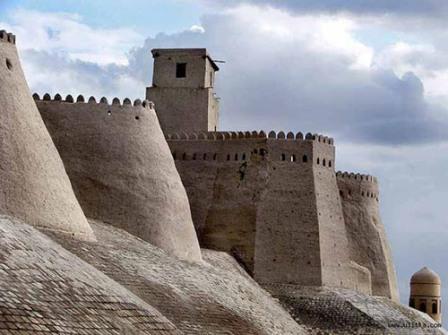 Based on archaeological data, Khiva had already existed in the V-VI centuries as a stop or a caravanserai in the well Kheyvak on the ancient route from Merv to Gurganj. For this reason, archaeologists believe that the reason the walls of Ichan-Kala are some remnants of an ancient fortification around the caravanserai, dating from the V century. Legend tells us that a Kheyvak well, the water of which had amazing flavor, was dug by Shem, the son of the biblical Noah.
Based on archaeological data, Khiva had already existed in the V-VI centuries as a stop or a caravanserai in the well Kheyvak on the ancient route from Merv to Gurganj. For this reason, archaeologists believe that the reason the walls of Ichan-Kala are some remnants of an ancient fortification around the caravanserai, dating from the V century. Legend tells us that a Kheyvak well, the water of which had amazing flavor, was dug by Shem, the son of the biblical Noah.
Kheyvak Well and today is located at the north-western wall of Ichan-Kala. When repairing wells had traces of ancient masonry structures and the remains of the dome, covered the ground now. Clay for the construction of the walls took about two kilometers from the city, in an area Govuk-kul, and now there is a large lake. And today, as always, good quality local clay used by modern potters. Legend has it that when the Prophet Muhammad had built Medina, used clay from these places, and the lake, which appeared later, is considered to be a saint.
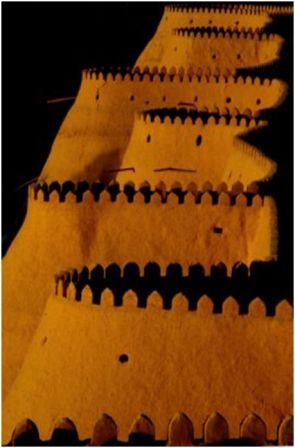 Inner City covers an area of 30 hectares and has a rectangular plan. Khiva is located within the fortress Ichan-Kala in XVI-XVII centuries and was surrounded by a thick clay wall, which reached a height of 8-10 m, depth - 6.8 m, length - 2,200 m. Fortified walls of Ichan-Kala with semicircular towers along the perimeter provide effective protection of Khiva. At the top of the wall was a lancet gallery with loopholes and battlements. In the system of defensive trenches were filled with water. Even now it is evident in the topography in the southern part, while in the north and west of the old asphalt covered ditches.
Inner City covers an area of 30 hectares and has a rectangular plan. Khiva is located within the fortress Ichan-Kala in XVI-XVII centuries and was surrounded by a thick clay wall, which reached a height of 8-10 m, depth - 6.8 m, length - 2,200 m. Fortified walls of Ichan-Kala with semicircular towers along the perimeter provide effective protection of Khiva. At the top of the wall was a lancet gallery with loopholes and battlements. In the system of defensive trenches were filled with water. Even now it is evident in the topography in the southern part, while in the north and west of the old asphalt covered ditches.
In the center of each of the four parts of the walls of Ichan-Kala located Darwaza (gate), which were also part of the defense system. On the example of the surviving gates can be seen that they have a "shock" of the tower located on both sides of the arched passage, and over the gate, there are also viewing the gallery. Western - Ata-Darwaza located at the inner Khan citadel Kunya-Ark, the northern - Bakhcha-Darwaza go on the road to Urgench, Oriental - Pahlavan-Darwaza – to Khazarasp and directed to the Amudarya River, south - Tash-Darwaza – to the sands of the Karakum desert. Ata-Darwaza Gate were destroyed in 1920 during the storming of the fortress by the Red Army and again rebuilt in the 70th years of XX century.
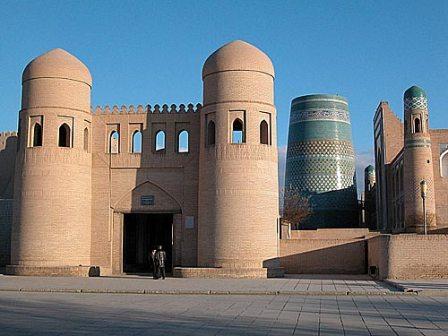 In the historical center of Khiva, in particular the Ichan-Kala fortress, a significant amount of architectural monuments, including Khan's palaces, mosques, mausoleums, minarets. Most of the monuments of Khiva was built in the XVIII-XIX centuries. At this time in the Khorezm oasis formed a kind of architectural style, which is marked by widespread use of majolica cladding, wood carving, marble and alabaster plaster. Thanks to many of the buildings of Khiva different intricate patterns, which covers the columns, arches, walls, arches, doors. A peculiar feature of many buildings is lined cupolas on the towers of blue tiles, the color of which is dissolved in the blue sky. Also one of the advanced types of applied art of the ancient Khorezm is wood carving. Therefore, in Khiva around you can see the wooden pillars and doors are decorated with exquisite carvings.
In the historical center of Khiva, in particular the Ichan-Kala fortress, a significant amount of architectural monuments, including Khan's palaces, mosques, mausoleums, minarets. Most of the monuments of Khiva was built in the XVIII-XIX centuries. At this time in the Khorezm oasis formed a kind of architectural style, which is marked by widespread use of majolica cladding, wood carving, marble and alabaster plaster. Thanks to many of the buildings of Khiva different intricate patterns, which covers the columns, arches, walls, arches, doors. A peculiar feature of many buildings is lined cupolas on the towers of blue tiles, the color of which is dissolved in the blue sky. Also one of the advanced types of applied art of the ancient Khorezm is wood carving. Therefore, in Khiva around you can see the wooden pillars and doors are decorated with exquisite carvings.
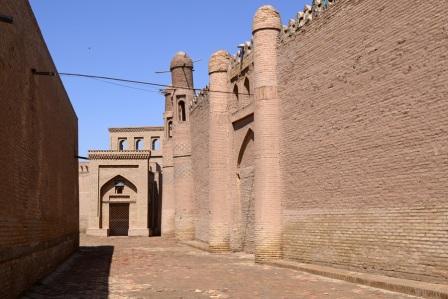 No less important landmark of Ichan-Kala is its own plan, which retained the old typical eastern cities a complex network of small streets and dead ends.
No less important landmark of Ichan-Kala is its own plan, which retained the old typical eastern cities a complex network of small streets and dead ends.
Ichan-Kala, an area of less than 1 square kilometer, densely built up, so the attractions of Khiva are very compact, small area bounded by the city walls. Most visitors enter the city through the west gate of the Ata-Darwaza, which is located to the left of the old citadel Kunya Ark, some of which date back to V c.
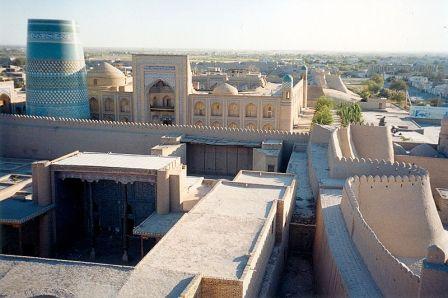 To the right of the gate is located Madrassah of Muhammad Amin Khan. The grand, but the unfinished minaret Kalta Minar is a little ahead. Approximately 200 meters closer to the city center, located Madrassah of Muhammad Rahim Khan II. Behind him, near the east gate, the palace Tash Hawley (XIX century) and madrasah Alla-Kuli Khan. In a 5-minute walk south of the town center is a mausoleum of Said Alauddin, and delightful Pahlavan Mahmud Mausoleum, madrassah Shergazi Khan, as well as a mosque and minaret Islam Khoja.
To the right of the gate is located Madrassah of Muhammad Amin Khan. The grand, but the unfinished minaret Kalta Minar is a little ahead. Approximately 200 meters closer to the city center, located Madrassah of Muhammad Rahim Khan II. Behind him, near the east gate, the palace Tash Hawley (XIX century) and madrasah Alla-Kuli Khan. In a 5-minute walk south of the town center is a mausoleum of Said Alauddin, and delightful Pahlavan Mahmud Mausoleum, madrassah Shergazi Khan, as well as a mosque and minaret Islam Khoja.
A total in the fortress is located 60 valuable ancient monuments and some 400 houses and residential buildings of historical significance.
As for the outer city - Dishan-Kala, this residential zone, formed around the Ichan-Kala, which was previously also walled.
In preparing the articles used material sites http://vostokcafe.com, wikipedia.org and http://www.topcastles.ru
 The mysterious city Khiva has managed to keep the image of an exotic eastern city in its oldest part - the fortress Ichan-Kala, where there are numerous monuments. In Khiva city, there traditional division into two separate one from the other parts: the inner city - Ichan-Kala and the outer city - Dishan-Kala. Ichan-Kala became the first UNESCO World Heritage Site in Central Asia. Erected over the centuries, the fortifications and palaces, mosques and madrasas, mausoleums and minarets, caravanserais and baths made of Ichan-Kala in a unique city-museum. The official status of the ancient city of Khiva was the reserve in 1968.
The mysterious city Khiva has managed to keep the image of an exotic eastern city in its oldest part - the fortress Ichan-Kala, where there are numerous monuments. In Khiva city, there traditional division into two separate one from the other parts: the inner city - Ichan-Kala and the outer city - Dishan-Kala. Ichan-Kala became the first UNESCO World Heritage Site in Central Asia. Erected over the centuries, the fortifications and palaces, mosques and madrasas, mausoleums and minarets, caravanserais and baths made of Ichan-Kala in a unique city-museum. The official status of the ancient city of Khiva was the reserve in 1968. Based on archaeological data, Khiva had already existed in the V-VI centuries as a stop or a caravanserai in the well Kheyvak on the ancient route from Merv to Gurganj. For this reason, archaeologists believe that the reason the walls of Ichan-Kala are some remnants of an ancient fortification around the caravanserai, dating from the V century. Legend tells us that a Kheyvak well, the water of which had amazing flavor, was dug by Shem, the son of the biblical Noah.
Based on archaeological data, Khiva had already existed in the V-VI centuries as a stop or a caravanserai in the well Kheyvak on the ancient route from Merv to Gurganj. For this reason, archaeologists believe that the reason the walls of Ichan-Kala are some remnants of an ancient fortification around the caravanserai, dating from the V century. Legend tells us that a Kheyvak well, the water of which had amazing flavor, was dug by Shem, the son of the biblical Noah. Inner City covers an area of 30 hectares and has a rectangular plan. Khiva is located within the fortress Ichan-Kala in XVI-XVII centuries and was surrounded by a thick clay wall, which reached a height of 8-10 m, depth - 6.8 m, length - 2,200 m. Fortified walls of Ichan-Kala with semicircular towers along the perimeter provide effective protection of Khiva. At the top of the wall was a lancet gallery with loopholes and battlements. In the system of defensive trenches were filled with water. Even now it is evident in the topography in the southern part, while in the north and west of the old asphalt covered ditches.
Inner City covers an area of 30 hectares and has a rectangular plan. Khiva is located within the fortress Ichan-Kala in XVI-XVII centuries and was surrounded by a thick clay wall, which reached a height of 8-10 m, depth - 6.8 m, length - 2,200 m. Fortified walls of Ichan-Kala with semicircular towers along the perimeter provide effective protection of Khiva. At the top of the wall was a lancet gallery with loopholes and battlements. In the system of defensive trenches were filled with water. Even now it is evident in the topography in the southern part, while in the north and west of the old asphalt covered ditches. In the historical center of Khiva, in particular the Ichan-Kala fortress, a significant amount of architectural monuments, including Khan's palaces, mosques, mausoleums, minarets. Most of the monuments of Khiva was built in the XVIII-XIX centuries. At this time in the Khorezm oasis formed a kind of architectural style, which is marked by widespread use of majolica cladding, wood carving, marble and alabaster plaster. Thanks to many of the buildings of Khiva different intricate patterns, which covers the columns, arches, walls, arches, doors. A peculiar feature of many buildings is lined cupolas on the towers of blue tiles, the color of which is dissolved in the blue sky. Also one of the advanced types of applied art of the ancient Khorezm is wood carving. Therefore, in Khiva around you can see the wooden pillars and doors are decorated with exquisite carvings.
In the historical center of Khiva, in particular the Ichan-Kala fortress, a significant amount of architectural monuments, including Khan's palaces, mosques, mausoleums, minarets. Most of the monuments of Khiva was built in the XVIII-XIX centuries. At this time in the Khorezm oasis formed a kind of architectural style, which is marked by widespread use of majolica cladding, wood carving, marble and alabaster plaster. Thanks to many of the buildings of Khiva different intricate patterns, which covers the columns, arches, walls, arches, doors. A peculiar feature of many buildings is lined cupolas on the towers of blue tiles, the color of which is dissolved in the blue sky. Also one of the advanced types of applied art of the ancient Khorezm is wood carving. Therefore, in Khiva around you can see the wooden pillars and doors are decorated with exquisite carvings. No less important landmark of Ichan-Kala is its own plan, which retained the old typical eastern cities a complex network of small streets and dead ends.
No less important landmark of Ichan-Kala is its own plan, which retained the old typical eastern cities a complex network of small streets and dead ends. To the right of the gate is located Madrassah of Muhammad Amin Khan. The grand, but the unfinished minaret Kalta Minar is a little ahead. Approximately 200 meters closer to the city center, located Madrassah of Muhammad Rahim Khan II. Behind him, near the east gate, the palace Tash Hawley (XIX century) and madrasah Alla-Kuli Khan. In a 5-minute walk south of the town center is a mausoleum of Said Alauddin, and delightful Pahlavan Mahmud Mausoleum, madrassah Shergazi Khan, as well as a mosque and minaret Islam Khoja.
To the right of the gate is located Madrassah of Muhammad Amin Khan. The grand, but the unfinished minaret Kalta Minar is a little ahead. Approximately 200 meters closer to the city center, located Madrassah of Muhammad Rahim Khan II. Behind him, near the east gate, the palace Tash Hawley (XIX century) and madrasah Alla-Kuli Khan. In a 5-minute walk south of the town center is a mausoleum of Said Alauddin, and delightful Pahlavan Mahmud Mausoleum, madrassah Shergazi Khan, as well as a mosque and minaret Islam Khoja.














